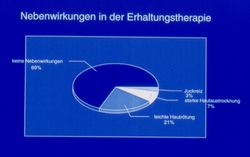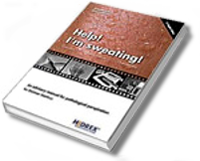current therapy with tap water - TWI
In practice, therapy by means of iontophoresis looks as follows, assuming for better illustration the presence of palmoplantar involvement, i.e. hyperhidrosis on hands or feet.
TWI in practice
In the treatment practice, the patient immerses hands or feet in a shallow plastic bowl half-filled with water. Two electrodes are placed in it, which generate a weak current that causes a slight tingling sensation in the affected person. With the help of a power source (iontophoresis device), a direct current is passed through the hands or feet via the electrodes. This current slows down the secretion of the sweat glands, whereby the sweat-reducing effect depends on the current strength (usually approx. 10-15 mA) and the duration of the current treatment.
Depending on the nature of the device, one treatment lasts about 20-30 minutes. Initially, the treatment should be performed daily, but at least three times a week in order to achieve a reasonably effective therapeutic result. The application of this physical method should be varied according to the severity of the hyperhidrosis and the individual circumstances.
and the individual circumstances, and changes in the application of the procedure should only be made in consultation with the treating dermatologist.
Sweating usually normalizes after 10-15 treatments. However, it turns out to be disadvantageous that the effect of the sweat inhibition after an intensive treatment is relatively quickly flattened again and thus a repetition of the application becomes necessary. With regard to the intervals between treatment repetitions, there are usually serious individual differences, so that there is no general information on this.
nebenwirkunsgarme Therapie

The advantage of iontophoresis therapy compared to other therapeutic measures lies mainly in the simplicity and ease of application. In addition, this procedure is almost completely free of side effects, in contrast to drug therapies or surgical interventions. The treatment is therefore risk-free and in most cases highly effective. In the few cases of side effects that have occurred so far, only accompanying symptoms such as a slight burning sensation, stinging, blistering of the skin or minor skin irritation have been observed, which in comparison to the side effects of medication or even neurosurgical hyperhidrosis therapy, however, is an entirely tolerable circumstance. Moreover, such side effects occur only as absolute isolated cases. Due to these obvious advantages, which are justified by an iontophoresis treatment, this method advances to the primary therapy measure of a hyperhidrosis. Long-term side effects are also relatively unknown among patients, even when they hardly occur even if those affected have already taken advantage of repeated therapies several times.



